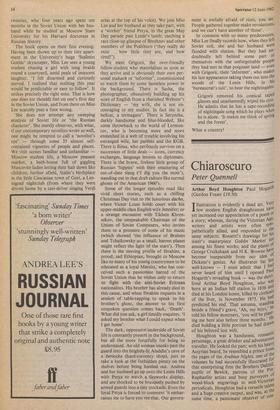Chiaroscuro
Peter Quennell
Hogarth
Arthur Boyd Houghton Paul (Gordon Fraser £19.50)
Illustration is evidently a dead art. Very few modern English draughtsmen have yet increased our appreciation of a poem or a story; whereas, during the Victorian Age' writers and artists were often sY111- pathetically allied, and responded to the same subjects. Rossetti's drawings for his sister's masterpiece Goblin Market are, among his finest works; and the plates 01 George Cruikshank and H.K. Browne have become inseparable from our idea °I Dickens's genius. An illustrator far less well-known — I must admit that I had, never heard of him until I opened Paw Hogarth's revealing book — was the short- lived Arthur Boyd Houghton, who was born at an Indian hill station in 1836 and died at his London home, killed by cirrhosis of the liver, in November 1875. He tied predicted his end. That autumn, standing beside a friend's grave, `Ah, my boys,' he told his fellow mourners, 'you will be plan ing me here also before three months.' tle died holding a little portrait he had drawn of his beloved lost wife. Houghton was a handsome, romantic personage, a great drinker and adventurous traveller. He looked the part; with his heavy Assyrian beard, he resembled a prince from the pages of the Arabian Nights, one of the volumes he had successfully illustrated for that enterprising firm the Brothers Dalziel, pupils of Bewick, patrons of the Pre; Raphaelite artists and busy purveyors of wood-block engravings to mid-Victorian periodicals. Houghton had a versatile talent and a huge creative output;and was, at the same time, a passionate observer of con- temporary London life. During his youth he produced a succession of street scenes, almost as crowded and animated as the can- vases of Frith, and some delightful evoca- tions of Victorian seaside holidays, 'The Donkey Ride, 1862', and `Ramsgate Sands', exhibited the following summer.
Houghton's companions on these holidays were his wife and first two children. In 1861, he had married a Pre- Raphaelite 'stunner', Susan Elizabeth Gronow (niece of Captain Gronow, the celebrated memoirist), and her big-eyed, calmly pensive face appears again and again in her husband's earlier pictures. Alas, she died after the birth of their third child — a tragedy that changed both the course of Houghton's personal existence and his Practice of his art. Tormented by loneliness and self-reproach, he plunged into bohem- ian dissipations, and, as he grew older, took to heavy drinking. At his studio, we learn, Where he kept open house, not only for his friends and colleagues but for a horde of local vagrants, if the bar threatened to run dry he would blow a powerful hunting- horn, which summoned a potman from the neighbouring tavern.
Some of his most imaginative engravings, executed while his sense of loss was still acute, make a curiously sinister impression for example, a strange design entitled The Pleasures and the Pains of Childhood'. Two little girls are shown reluctantly going to bed,' the elder, whose broken candle is falling, terrified because a door has mysteriously caught her night- gown and a macabre row of adult coats and hats dangles above her on the wall. Another, 'The Mock Burial', has surely a symbolic connection with poor Susan's useless death. It represents a group of carefree children on a beach burying their submissive pet dog in the sand. , The dark side of Houghton's imagination became particularly apparent when, as a Pictorial reporter employed by the Graphic, he visited the United States and France. America he seems to have considered at once attractive and repulsive. Having studied New York and explored its back streets and its grim gaols, he investigated the bizarre religious communities of the Mormons and the 'Shakers', attended savage buffalo-hunts and ghostly Indian dances, and, wherever he went, despite the hardships he endured and the dangers he ran, recorded exactly what he saw in a forceful and dramatic style. Even more dramatic are the sketches he made of revolutionary Paris, during the wild explo- sion of the Commune and the bloody reprisals that succeeded it. Meanwhile, the domestic charm that characterised many of his earlier drawings had almost completely disappeared, His line was harder and coarser; he was a vigorous journalist rather than a commemorative artist. The emphasis usually falls on human violence and cruelty.
Houghton was a highly skilled technician Wood-block engraving is an exceedingly
cliff' craft; and he had increased the ap- 'nude with which he handled the disposi-
tion of black and white through his knowledge of Utamaro's prints. He was also a prodigiously hard worker, who laboured against appalling obstacles; as a boy, he had lost the sight of one eye; and he suffered all his life from terrible migraine headaches. In his own day, his accomplish- ment was much admired; and, although not himself a man of genius, he appealed to greater artists. Van Gogh knew his illustra- tions well, and once wrote to his brother Theo that Houghton had 'something mysterious like Goya, with a wonderful soberness which reminds me of Meryon'; and, elsewhere, that he 'made up for many other things' that were 'repugnant in the English world'. A book by Laurence Housman is the only previous tribute paid to Houghton's character and work. I hope that Mr Hogarth's monograph, which is both learned and understanding, will help to restore him to the position he deserves.





































 Previous page
Previous page